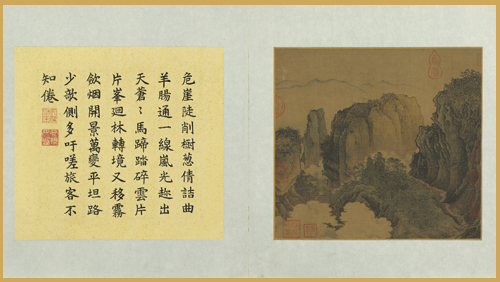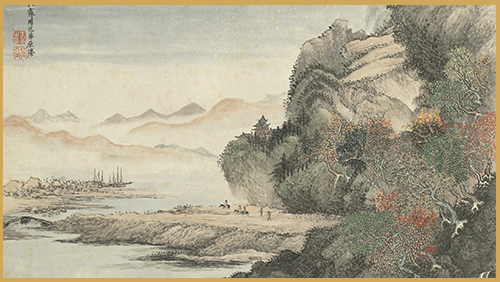
Many artists starting in the Southern Song period (1127-1279) came under the influence of Fan Kuan’s style, as seen in Xiao Zhao’s (fl. 12th c.) “Travelers in a Mountain Pass” and Xia Gui’s (fl. ca. 1180-1230) “Landscape” from the Museum collection. Their bold and powerful brushwork like cast iron echoes the quality seen in “Travelers Among Mountains and Streams.”
Numerous painters in the Ming and Qing dynasties also profess in their inscriptions to be “imitating Fan Kuan,” “in the (brush) method of Fan Huayuan (Kuan),” or “after Fan Zhongli (Kuan).” Although their styles are not quite similar to “Travelers Among Mountains and Streams,” at least they provide an idea of the lofty status attached by later painters to Fan Kuan’s name and how they interepreted his style. Works included in this section include those by Shen Zhou (1427-1509), Wen Zhengming (1470-1559), Lan Ying (1585-after 1664), Wang Shimin (1592-1680), Wang Jian (1598-1677), Wang Hui (1632-1717), Tang Dai (1673-after 1752), and Zhou Kun (fl. 18th c.). Even in the late Qing and Republican period, during the twentieth century, artists continued to mention Fan Kuan in their inscriptions, revealing the depth of Fan’s long-lasting influence in Chinese art.

Travelers in a Mountain Pass
Xiao Zhao (fl. 12th c.), Song dynasty
Xiao Zhao, a native of Huoze (modern Yangcheng, Shanxi), fled to the Taihang Mountains after Jin armies invaded the Song and captured the court during the Jingkang Disaster of 1126. Becoming a bandit in the mountains, he later met and accompanied the court painter Li Tang (ca. 1070-after 1150) on his way south, serving as his student and eventually a Painter-in-Attendance at the court during Emperor Gaozong’s Shaoxing reign (1131-1162).
This is the tenth leaf from “Album of Famous Collected Paintings from Antiquity.” It bears neither seal nor signature of the artist, but the old label gives Xiao Zhao as the painter. In the square-shaped composition are peaks and ranges clustered with clouds and mists rising from the depths, the scenery lofty and expansive. A caravan proceeds along a path in the mountains. The brushwork throughout is strong and powerful, the texture lines dark and dignified to create forms like scraped iron in a style reminiscent of Fan Kuan’s (ca. 950-ca. 1031). The composition, however, has departed from the full monumental landscape scenery of the Northern Song to become a more isolated mountain view, indicating the painting is a transitional development on the Fan Kuan tradition during the Southern Song period (1127-1279).

In the Method of Fan Kuan’s Landscapes
Wang Hui (1632-1717), Qing dynasty
Wang Hui (style name Shigu, sobriquet Gengyan sanren), a native of Changshu, Jiangsu, received instruction in painting from Wang Shimin (1592-1680) and Wang Jian (1598-1677) while also studying widely from works of the ancient masters. Able to fuse both ancient and modern, he synthesized the Northern and Southern Schools of painting to become known as one of the “Six Masters of the Early Qing.”
This work is the tenth leaf from “Collaborative Album of Flowers and Landscapes” that Wang Hui did with Yun Shouping (1633-1690), who was responsible for the flower paintings. In Wang’s leaf here, trees with leaves turning red line the mountains in autumn as travelers slowly make their way on the path. At the left is the artist’s inscription that reads, “Using the method of Fan Huayuan (Kuan).” The foreground rocks continue in the tradition of “raindrop” texturing used by Fan Kuan (ca. 950-ca. 1031), the application of the brush complex yet delicate. Mineral green and red pigments were applied to the clusters of trees to imbue them with a sense of brightness and beauty, the colors of distant mountains and skies echoing each other in an exceptional arrangement of solid and void.




